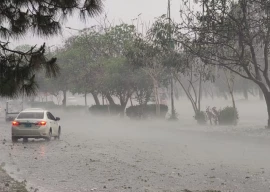
Last week, Chief Justice of the Lahore High Court Mansoor Ali Shah delivered an opinion in an environmental petition filed by Asghar Leghari, an aggrieved agriculturist, who, in view of the looming climate change of the country, sought protection of his right to sustenance — a fundamental covenant guaranteed under the Constitution. The judgment delivered unprecedentedly gives leeway for the recognition of ‘climate’ and ‘water justice’ under the legal umbrella of Articles 9 and 14 of the Constitution; the former pertains to the right to life, whilst the latter encompasses the inviolability of dignity of man. The nature of the petition was uncommon, in that it was taken up by the court as a continuing mandamus — the phrase is broadly understood to be a series of ongoing directions/orders of the court.
Pakistan’s environmental jurisprudence was previously constituent of environmental justice; the term connotes the dispute resolution of environmental issues in a localised context. In instances of environmental justice, the polluter is usually always ascertainable for the purposes of slapping punitive measures, such as the halting of the pollutant producing operations. This was an individualised approach, with the recipients of justice always being confined to a number, an area or locality. With the advent of cases like the signal-free corridor (Imrana Tiwana), however, the jurisprudential plane has experienced a shift in paradigm to a ‘climate justice’-centred approach. The latter indulges into transcendence from an initially linearised narrative to a more society-centered approach. Climate justice, dissimilar to its predecessor, has the benefit of ensuring the collective protection of rights and universal reaping of benefits to the society-at-large. This is in contra-distinction to environmental justice wherein the justice delivered is normally localised by a single person, or a select section of society.
Climate justice adds substance to environmental justice by emphasising adaptive capacity. They are better understood if categorised as proactive and reactive, respectively. Climate justice involves adaptive capacity: knowing when to strike against climate change. Environmental justice, on the other hand, centres on the act of raising the shield — mitigation. Environmental justice is much more confined in its scope, for example: aiming to reduce the rates of emission of greenhouse gases. Adaptive measures, however, inject a policy-centred approach by engaging stakeholders across the board and stressing on the ability to respond to sudden climate changes by offsetting their effects. It illustrates the ability to adjust, in reaction, to actual or expected climatic stimuli or their effects. Adaptive capacity can only be achieved when all stakeholders join the environmental dialogue and agree to, inter alia, reinvent the operations of their respective departments or organisations; examples are governmental, food, water, energy or disaster management authorities. Owing to the judgment last week, climate justice is now a tenet enshrined under Articles 9 and 14 of the Constitution. This means that the progress and implementation of adaptive capacity to global warming can always be monitored and enforced by the courts under the garb of climate justice.
Water justice, as referred to in the judgment, is a sub-concept of climate justice. It refers to the right of individuals to the access of clean water. Water justice requires all communities be able to access and manage water for beneficial uses along with recreational purposes. In the words of the court, adjudication of water-related disputes has to be mindful of the inseparability of water with eco-systems.
Aggrieved citizens will be entitled to enforce their rights to climate and water justice. An act promulgated by the federal government last year, the Pakistan Climate Change Act, 2017, constitutes a Climate Change Authority, whose mandate is, in a broad-brush manner, entrusted with the formulation of comprehensive adoption and mitigation polices to address climate change. It is only when these policies run their due course in time, will we be able to gauge their effectiveness. The laudable opinion of the court, however, enables us all to act in a regulatory capacity by ensuring governmental departments are consistently building their adaptive capacity, whilst hand-in-hand ensuring the protection of our rights under the constitution. It is high time we began to proactively monitor the effectiveness of governmental departments charged with the responsibility of curbing climate change. In the midst of raising our shields, we must forget not to strike with the sword.
Published in The Express Tribune, February 7th, 2018.
Like Opinion & Editorial on Facebook, follow @ETOpEd on Twitter to receive all updates on all our daily pieces.













COMMENTS
Comments are moderated and generally will be posted if they are on-topic and not abusive.
For more information, please see our Comments FAQ